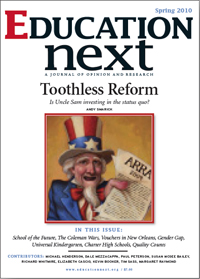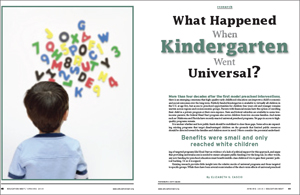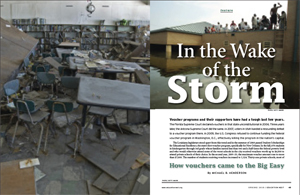For far too long, studies and reports about our nation’s high schools have been great at diagnosing problems and highlighting failures. “The Unknown World of Charter High Schools” (research, Spring 2010) offers a refreshing change from the typical “gloom and doom” by providing evidence that public charter students in Chicago and Florida have significantly higher graduation and college attendance rates than their peers in traditional public schools.
“The Unknown World of Charter High Schools” is an important research document for two reasons. First, it focuses not on student achievement, but more importantly, on educational attainment, specifically, high school graduation and college matriculation. Unfortunately, this “bottom line” research focus is rare. While studies showing growth on standardized tests can prove helpful, schools exist to prepare students to be productive and successful adults. Educational attainment is a much clearer indicator of school quality. A similar bottom-line approach has been central to our success at YES Prep Public Schools, and it is why we require every student to secure acceptance into a four-year college in order to receive a high school diploma.
Second, the methodology used in the study effectively addresses the usual creaming and self-selection arguments that arise with any study demonstrating positive student outcomes in public charter schools. By limiting the high school students in the study to those who attended a charter school for 8th grade, the authors account for the argument that charter students perform at higher levels simply because they are more motivated or come from families in which the parents are more involved in their education.
This outcomes-based focus and thoughtful research design gives the study the credibility that it needs to serve as an important “proof point” that extends beyond charter high schools. The study serves as an important step in identifying factors in school success. With this knowledge of “the what,” we can confidently dig deeper and better understand “the how.” Research like this combined with over a decade of practical experience and significant results at high-performing charter public high schools like YES Prep will unlock “the how” to high school reform so we can move past diagnosing the problem and begin implementing real and effective solutions for increasing high school and college completion rates across the country.
Chris Barbic
Founder and Head of Schools
YES Prep Public Schools
Coleman’s Legacy
Thanks to Paul Peterson for investigating the links between James Coleman’s adolescent experiences and his studies of adolescent life and high schools (“A Courageous Look at the American High School,” features, Spring 2010). Peterson provides a great service to scholars.
Peterson mentions Coleman’s experience at Manual High in Louisville, Kentucky, where he adjusted by becoming a member of the school’s football team. Coleman’s athleticism had roots deeper than the limited opportunities at his high school, however. His father and grandfather were both football heroes. I recall a comical scene at a graduate-student baseball game. Jim wanted two captains to choose their teams the old-fashioned way: one player at a time. Considering that most graduate students were working from their own adolescent experiences (i.e., their lack of childhood athleticism), a revolt was quickly organized. No one should have to be the last one chosen! All in jest, Jim settled for odd and even birth dates to establish the teams.
Coleman’s adult interest in adolescence was not limited to scholarly analysis. Most know of his attempts to develop academically related games that could stir the interest of adolescents. Fewer know of his weekly commitment to tutor a public high school’s mathematics team in Chicago.
While his competitive instincts remained with him as a scholar, so did his sense of fair play. As Tom Hoffer and I waded through all the commentaries and critiques of the study of public and private high schools, Jim had strict rules of engagement. Roughly, they were these: Concede well-founded criticisms first. Play on the critics’ court (i.e., you can’t use sociological arguments to criticize an economist). Protect the junior scholars and give seniors fair hits.
Sally B. Kilgore
President and CEO
Modern Red SchoolHouse Institute
In reading Paul Peterson’s thoughtful account of James Coleman’s research and its role in history, and of Daniel Patrick Moynihan’s reaction, I was reminded that Coleman’s big study came out a year after the Moynihan Report (1965). (I had done the research for Moynihan.) At that time, Moynihan’s report was in the middle of a firestorm, and I know he found some relief in learning from that study how important the family was.
While I have always thought that the family and neighborhood conditions were a very large factor in achievement differences, I have not thought that the Coleman report itself established the relative contributions of school and family. Poor neighborhoods and low-quality schools are interrelated, and it is very hard to sort it out.
Very much later I stumbled onto a 1972 article by Coleman titled “Policy Research in the Social Sciences” and found that Coleman did not think his study had established such relative contributions. He said that “The plan of the analysis was not appropriate for study of the relative effects of background and school variables, but it was correct for study of relative weights of different school variables.” One wonders how many people heard this from him.
As the father of the concept of “social capital,” Coleman would be pleased to know how far that concept has come, and that it has been applied in the monumental longitudinal study by a team led by Anthony Bryk (Organizing Schools for Improvement: Lessons from Chicago, 2010). The study established the strong relationship between the success of school improvement efforts and the strength of social capital in the neighborhoods where the schools were located. Our debt to Coleman is huge, as a pioneer on many important fronts.
Paul E. Barton
Education writer and consultant
Elizabeth Cascio (“What Happened When Kindergarten Went Universal,” research, Spring 2010) has estimated the effects of universal kindergarten to inform the debate about universal pre-K. She claims existing research provides little insight into the relative merits of universal programs and those targeted to specific groups.
While Cascio’s results are not fully consistent with other studies, the estimated one-fifth drop in incarceration for whites is intriguing. Ultimately, her effort is unsatisfying because her methods and data provide a weak basis for conclusions, and there is far more relevant information on the long-term effects than she acknowledges.
Too often the results of complex models such as Cascio’s owe more to the assumptions and idiosyncrasies of the way data are selected and coded than to reality. Despite the model’s complexity, there is too much that cannot be adequately taken into account: for example, the potential for schools to use the resources freed by state support for kindergarten to fund other services or reduce class sizes for older children; the effects of large, sudden increases in kindergarten enrollments on quality; large increases and decreases in cohort size over the time period studied; and immigration patterns over time. Among other problems, Cascio’s speculations about Head Start fail to consider the impacts on children who begin Head Start a year earlier as kindergarten replaced Head Start for those who were age five.
Cascio seems unaware of substantial evidence on the longer-term effects of preschool education programs other than model programs and Head Start, evidence that bears more directly on the question at hand. Several literature reviews (including Barnett in 2008 and Nores and Barnett in 2010) have summarized much of this work. The evidence includes the longitudinal study of Child Parent Centers operated by the Chicago Public Schools and studies of the effects of several state pre-K programs (including universal pre-K in Georgia) that find positive effects on achievement and reductions in grade repetition. Studies from abroad have found universal pre-K increased test scores, improved behavior, decreased grade repetition, and increased educational attainment. Finally, international comparisons indicate that as participation in pre-K moves beyond 60 percent toward universal, average test scores at age 15 rise and inequality in these scores declines.
Steve Barnett
Milagros Nores
National Institute for Early Education Research
Cascio responds:
Drs. Barnett and Nores leave the impression that I have overlooked a vast and relevant literature on the long-term effects of universal preschool. Yet almost all the U.S. programs they reference were targeted, not universal; short-term outcomes like test scores are not deterministically related to adult well-being, which was my focus; and experiences of other countries—with very different policy landscapes and populations—provide at least as weak a basis for drawing conclusions for the U.S. Moreover, I estimate the net effects of a large public investment in early education, not the effects of attending preschool per se. Large interventions may have effects that offset any benefits from attendance. That my estimates incorporate such responses may make them more, not less, instructive.
Thanks to Education Next for publishing Michael B. Henderson’s informative article on the voucher program in New Orleans (“In the Wake of the Storm,” features, Spring 2010). With so much attention being focused on the expansion of charter schools after Hurricane Katrina, these scholarships tend to be overlooked. Mr. Henderson’s piece serves as a useful reminder of the program’s existence as well as an informative description of how the legislation was passed.
Unlike the charter schools, which have received broad support since their inception, the voucher program was a “heavy lift” for Governor Bobby Jindal. He and the legislature deserve much credit for taking this on. It would have been easy for reformers to use the continuing expansion of charter schools as an excuse for inaction on the voucher front, but thanks to their commitment hundreds of children can now attend the school of their choice.
In some respects, the expansion of charter schools made it harder for voucher advocates to make a compelling case for their need. But as Mr. Henderson describes, effective advocacy by organizations including the Archdiocese of New Orleans and the Black Alliance for Educational Options helped build support for these scholarships.
As Mr. Henderson points out, a number of conditions made it possible for New Orleans to become a hotbed of school reform. Some of these conditions may be replicable in other cities and some may not. But what these reforms can do is lay the groundwork for change around the country.
Perhaps success in New Orleans will serve as a springboard for expanding school choice in cities that still cope with inflexible unions and reluctant policymakers. That could be a more likely, and more beneficial, outcome than hoping that someone can replicate the unusual path to school choice that has been taken here in New Orleans.
Kevin Kane
President
Pelican Institute for Public Policy





